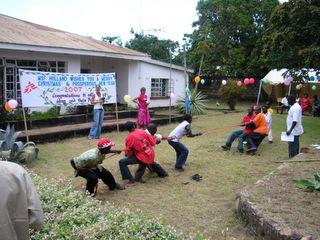Not Just Another Day at the Office
I can almost see the travel brochure now:
“Travelling by open boat from Nchelenge, you brave the elements as you speed along Lake Mweru. Fear not…although it may not be apparent, the captain is well trained or at least experienced. Upon entering the Luopula River you will be literally sailing along the border between Zambia (formerly Northern Rhodesia) and the Democratic Republic of Congo (formerly Zaire). The friendly Bemba people from both countries will wave enthusiastically as you pass their villages. At the conclusion of your 90-minute cruise you will disembark for a walking tour of some villages on Chisenga Island. Observe the men mending their fishing nets and the women attending to their domestic chores. You will be warmly received, especially by the children who will follow you as though you are the Pied Piper. This trip assures that no other tourist will be on the island on that day or probably in recent history. You are guaranteed to remember this one-day adventure for a lifetime.”
Of course, this isn’t a description of a tourist adventure, but of how I spent a recent day working with MSF. Vera, the Project Coordinator, had suggested that I join the team making this trip as it contribute to my understanding of the work being done by MSF. Although she was too nice to say so, she probably also saw this as an opportunity to get me out of her hair for a day. Regardless of her motives I am in her debt for providing me with one of those experiences that makes even the most seasoned traveler go “Wow!”
MSF started work in Zambia in 1999, in three Congolese and Angolan refugees camps. After that project ended, HIV/AIDS was identified as a main public health issue and MSF set-up a program in the remote and rural district of Nchelenge. MSF has integrated its activities into the nine rural government health centres, with MSF staff working alongside the Ministry of Health (MoH) staff, and HIV positive /AIDS patients are seen alongside the other patients. The main objectives are to bring quality of medical and psychosocial diagnosis, treatment and care and counseling as close as possible to people living with HIV/AIDS as well as to prevent the spread of the disease through increased information education and communication services. MSF Holland is planning on handing-over these activities to the MoH and leave Zambia by the end of 2007.
Chisenga Island is the location of one of these rural health centres and is by far the most remote. After hanging around the health centre for a while I went for a walk and before too long I was being trailed. A growing army of children with nothing better to do happily followed my path. Periodically, I would suddenly turn and yell “boo,” and then run a couple of steps in their direction. They would squeal with delight, with the older ones retreating just a short distance and then holding their ground and the younger ones running further. When things settled down my group of followers would have inevitably grown larger. This was fun for a while, but even when I had ended my game and returned to the clinic to sit in the shade many of the children had remained, hopeful that I would provide further entertainment.
It was not to be, however, as in the early afternoon it was time for the return trip by boat to Nchelenge. So ended one of those days never to be forgotten. Just like what you read about in the tourist brochures.







